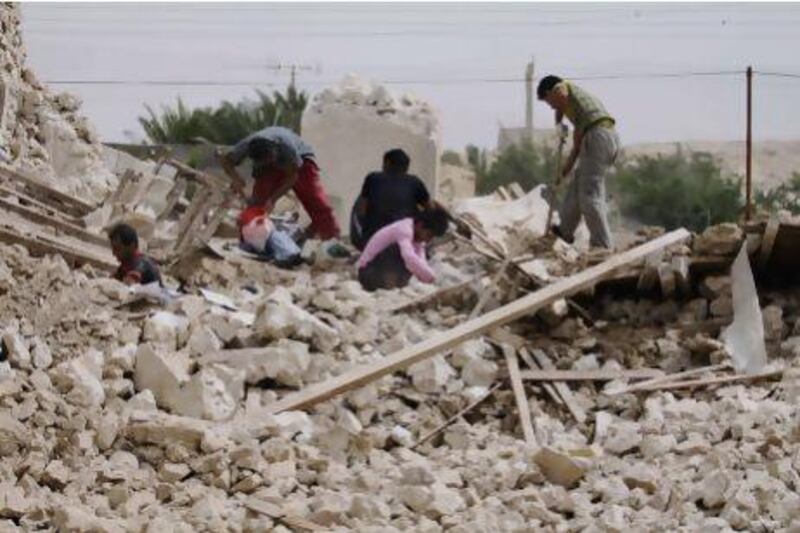Tehran announced plans to build more nuclear reactors in an earthquake-prone coastal area facing its Arabian Gulf neighbours, a day after a powerful tremor struck near Iran's only atomic energy plant.
The death toll from Tuesday's 6.3-magnitude quake rose to at least 37 yesterday. It struck 90 kilometres south-east of the port of Bushehr, injured more than 900, flattened about 12 villages and damaged dozens more. The dead included eight children under the age of 10.
Sheikh Khalifa, the President, sent a message of condolence to the Iranian president Mahmoud Ahmadinejad.
Tremors from the quake were also felt in the UAE, Bahrain, Qatar and Kuwait. In Dubai and Abu Dhabi, some high-rise buildings were evacuated.
The nuclear power plant near Bushehr, which Iran insists is quake-proof, escaped unscathed.
Within hours, the head of Iran's Atomic Energy Organisation said more reactors would be built there. Fereydoun Abbasi-Davani declared the Bushehr site capable of holding six reactors and said construction of two more units of at least 1,000 megawatts would start there in the "near future".
Residents were expected to spend a second night in the open after dozens of powerful aftershocks, including one yesterday morning with a magnitude of 5.2.
After pulling 20 people from the rubble, Iran's Red Crescent was confident no more survivors were trapped in shattered buildings and wound up its search and rescue efforts.
Ali Alipour, who owns a cultural centre in the village of Khormoj, about 35 kilometres from the quake's epicentre, ran for cover when it hit and "the sound of death filled the fields".
As Iran declared three days of mourning, the focus shifted to relief operations for the living - distributing food, water, tents and blankets, and reconnecting electricity and telephone lines.
Iranian officials said 800 houses were destroyed in the affected area, a sparsely populated rural part of Iran where about 12,000 people live. Many houses are made of home-made mud bricks that can crumble easily in a strong quake.
The rapid rescue operation highlighed that residents in tightly knit village communities knew each other well, and knew where to look. Most of the collapsed buildings were small.
Of those wounded, 750 had minor injuries and the rest were sent to provincial hospitals, said Bushehr's governor, Fereydun Hasanvand.
Iran was keen to reassure Gulf Arab states and the international community that the Bushehr nuclear power plant was not damaged. The site at Bushehr is closer to Kuwait City, Manama, Doha and Abu Dhabi than it is to Tehran.
Its chief engineer, Mahmoud Jafari, said "no operational or security protocols were breached". The Russian company that helped to build the plant offered similar reassurances.
Iran also promptly informed the UN's nuclear watchdog that the plant was intact and there had been no radioactive seepage. The International Atomic Energy Agency indicated that it was satisfied there was little danger.
It said that, based on its own analysis of the quake's magnitude, location and other factors, "it is not currently seeking additional information from Iran".
The Bushehr reactor is in an earthquake zone at the juncture of three tectonic plates, but is designed to withstand a quake of magnitude 8 and possibly up to magnitude 9, experts from the International Institute for Strategic Studies in London reported last year.
Iran is prone to earthquakes, some of which have been devastating. Ten years ago 30,000 people were killed by a 6.6-magnitude quake that hit the south-eastern city of Bam, destroying its famed ancient mud-brick citadel.
Last August more than 300 people were killed when twin quakes struck north-west Iran.
The worst recorded disaster was in June 1990, when 50,000 people died in a 7.4-magnitude quake that devastated the Caspian regions of Gilan and Zanjan.
Residents in Tehran have long feared that their sprawling city of 12 million could be next.
The city - hit by a 7-magnitude quake in 1830 - is perched on geological faults. Some experts estimate as many as 700,000 of Tehran's residents could die if a "big one" struck again, leaving the country "decapitated".
Some Iranian geophysicists have suggested that the capital be moved to a safer part of the country, a proposal first mooted in 1991.
[ mtheodoulou@thenational.ae ]
twitter: For breaking news from the Gulf, the Middle East and around the globe follow The National World. Follow us





